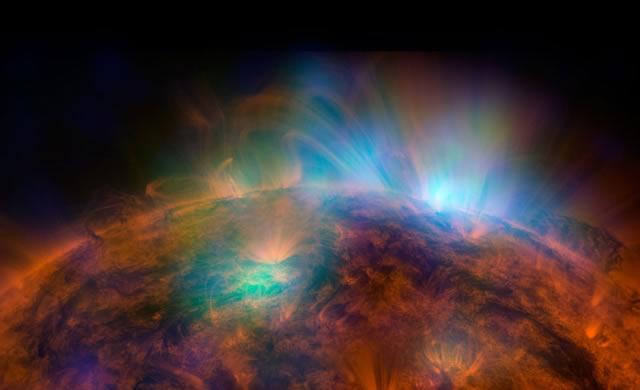
Credit: NuSTAR – SDO – NASA
Perché le regioni sopra le macchie solari sono così calde? Le macchie solari sono zone un po’ più fredde rispetto alla superficie solare che le circonda perché i campi magnetici che le creano riducono il riscaldamento convettivo. E ‘quindi strano che le regioni in testa, poste anche molto più in alto nella corona solare, possono essere centinaia di volte più calde.
Per aiutare a trovare la causa, la NASA ha posizionato il satellite nucleare spettroscopico in orbita intorno alla Terra, il Telescope Array (NUSTAR), in modo da puntare i suoi estremamente sensibili strumenti a raggi X verso il sole. Il primo piano ha rivelato il Sole in luce ultravioletta, mostrato in una tonalità di rosso come di solito appare tramite il Solar Dynamics Observatory (SDO). In sovrimpressione, nell’emissione di colore falsato verde e blu sopra le macchie solari rilevate da NUSTAR in diverse bande di raggi X ad alta energia, si evidenziano le regioni con temperature estremamente elevate. Indizi sui meccanismi del riscaldamento atmosferico del Sole non possono venire solo da questa immagine iniziale, ma le future immagini di NUSTAR saranno volte a trovare degli ipotetici nano-brillamenti, brevi esplosioni di energia che possono guidare l’insolito riscaldamento.
Why are the regions above sunspots so hot? Sunspots themselves are a bit cooler than the surrounding solar surface because the magnetic fields that create them reduce convective heating. It is therefore unusual that regions overhead – even much higher up in the Sun’s corona – can be hundreds of times hotter.
To help find the cause, NASA directed the Earth-orbiting Nuclear Spectroscopic Telescope Array (NuSTAR) satellite to point its very sensitive X-ray telescope at the Sun. Featured above is the Sun in ultraviolet light, shown in a red hue as taken by the orbiting Solar Dynamics Observatory (SDO). Superimposed in false-colored green and blue is emission above sunspots detected by NuSTAR in different bands of high-energy X-rays, highlighting regions of extremely high temperature. Clues about the Sun’s atmospheric heating mechanisms may not only come from this initial image, but future NuSTAR images aimed at finding hypothesized nanoflares, brief bursts of energy that may drive the unusual heating.
Source/Continue reading → Apod.Nasa.gov





















